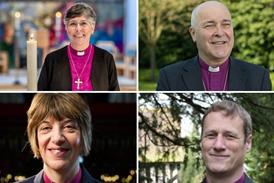Rev Dr Hannah Steele’s church in Peckham was transformed by the faithful prayers of a band of women who prayed for decades. It’s just one story of many green shoots of growth that are springing up across the Church, she says

It is often said that the Church in the West is at crisis point. Newspaper headlines tell us that Christianity is in decline in the UK and that, in our increasingly secular culture, religious faith should be a matter of personal preference, rarely seen and certainly not heard.
The church that I am part of was built in 1867. At that time, the existing church buildings in London could not cater for the expanding urban population. This, of course, was an era when most people went to church.
Now, as many of those Victorian buildings stand empty, are turned into fancy flats for city workers or performance venues, it can be hard to imagine a time when there wasn’t room for all the people who wanted to attend.
Shoots of renewal and revival are growing up in the most unlikely places
However, to borrow from Mark Twain, reports of the death of the Church in the West may be greatly exaggerated. Where I live, in Peckham, south London, you feel out of place if you’re not carrying a Bible on the bus on Sunday morning.
Just one mile from my house lies the beginning of the Old Kent Road. On its 1.5-mile stretch, you will find more than 25 Black majority churches - and there are at least 200 in the surrounding area. I have often thought that if someone were to make a church version of monopoly, the Old Kent Road’s fortunes would be greatly changed!
A story of hope
I first visited All Saints Peckham some 27 years ago. At that Sunday service, there were about 20 people in a vast, cold building which was designed for 600. However, the church was warm with love for God and neighbour - and there was a hopefulness that God was on the move.
As my husband and I made our home amongst this fledgling community, we encountered an incredible group of women of faith, most of whom came to the UK during the Windrush generation. They had been meeting weekly to pray for the last 30 years, trusting that God would build his church in Peckham.
Despite Diocesan plans to knock the church down and replace it with a smaller, more manageable chapel, God did the unimaginable and, week by week, new people joined. Some, like us, had newly moved into the area. Others came because they were exploring or new to faith. At one point, it was the fastest growing Anglican church south of the river Thames. Today, it continues to be a thriving and diverse community.
New shoots
Through my work at St Mellitus College, I have come to see that this story is not an anomaly, a freak incident that bucks the trend of decline. Up and down the country, signs of life and shoots of renewal and revival are growing up in the most unlikely places.
More good news stories from the Church
-
‘We’ve given out over 4,000 Bibles on the streets of London’
-
‘Deaths by despair’ are common in Blackpool. But we’re seeing Jesus changing lives
-
There is a hunger for God’s presence in young people that we haven’t seen before
-
‘More than 100 new local congregations have sprung up in the past five years’
-
‘We’re seeing people come to know Jesus more easily than we were five years ago’
In Essex, a group of mums who began gathering at a kitchen table after the school drop grew into an established worshipping community. In Oxfordshire, a church plant on a new housing estate has become a pivotal connection point for the local community. In Reading, a well-established church has become a place of home for refugees and asylum seekers. There are many many more.
Living for God
Lesslie Newbigin was a missionary to India for 40 years. When he returned to the UK in the 1970s, he was shocked by the increasingly secular and pluralistic nature of the British landscape. He spent his remaining years exploring ways in which the gospel could be made known in the changing culture of Western democracy.
One of the conclusions he reached was that some of the tried and tested evangelistic methods used to convince people that the Christian faith was true would not be enough. He believed that unchurched people would only see the Christian faith as credible when they saw a community who believed it and lived it out.
God did the unimaginable and, week by week, new people joined
The faith, hope and love of the praying women I encountered in Peckham 25 years ago was one such example of a community believing and living out the gospel. But it is not and cannot be the only example.
Believing for more
While a shiny new building and a healthy bank account will undoubtedly help us in our creative witness, the power of the gospel is demonstrated not in these things, but in women and men of faith, hope and love, who live out the good news of Jesus Christ.
It seems that the answer to the decline of the Church in the West lies within the Church - and not outside it. What if we met predictions of impending extinction by believing more in its power – the power we, as members of the Church, have to live out the gospel story as a community together?
What might happen if we followed the example of those who went before and prayed with faith for God to rebuild his Church? I, for one, am expectant of what the next few decades will hold.





























2 Readers' comments